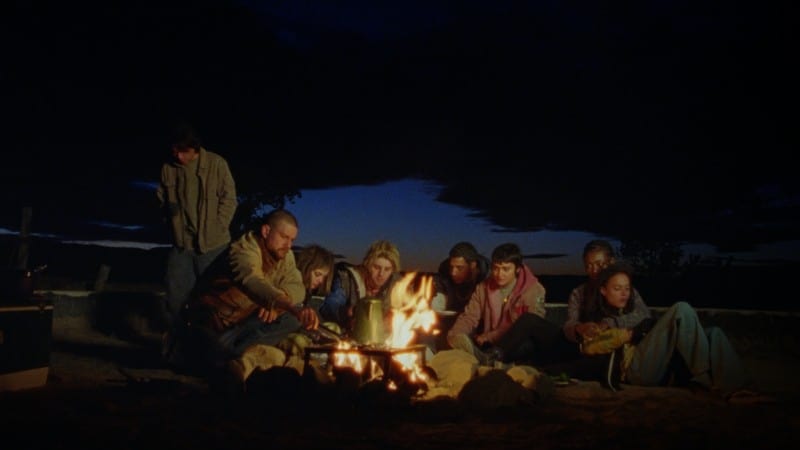The stellar How to Blow Up a Pipeline is like Ocean’s Eleven with horrifically real implications. In an age defined by government inaction on the climate crisis, which is already responsible for the deaths of millions, there is a certain catharsis in watching this film, which centers on a group of brave young activists who decide to fight for their future. It is the kind of righteous heist movie our planet needs.
Based on a nonfiction book of the same name by Andreas Malm, this fictitious film centers on a group of young activists who willingly commit what they know their government and the media will brand domestic terrorism. But they do not care. They see blowing up infrastructure like pipelines as a necessary act. What is a pipeline compared to the actual deaths such industries cause? The film’s moral defense of sabotage is an audacious revelation. This climate change film clearly captures the anxiety and anger of the generation who will inherit this planet, which has the potential to upend how we think and talk about this crisis.
Politics aside, How to Blow Up a Pipeline is also a technically superb film. Director Daniel Goldhaber, who co-wrote the script with Ariela Barer and Jordan Sjol, has created a suspenseful tale that will stand up against the best action films of recent years. Tapping into the heist genre, we witness a band of people with various motivations gather in West Texas for the mission. The film tells the story of the pipeline’s destruction in real-time while cutting back to share each person’s origin story. Editor Daniel Garber gives the film a tremendous rhythm. Even when the film cuts to backstories at the height of the action, we never lose our sense of place or suspense.
Goldhaber smartly foregrounds the film’s political message and narrative flow rather than veering too far into character studies and other subplots. Yet we get to know each character just enough to feel fully invested in their mission beyond the cause. How to Blow Up a Pipeline is precision filmmaking at its finest. While some characters emerge as more compelling than others, each gets their story shared on screen. Everyone has their own reasons for participating in this struggle. And the film does a fine job of clarifying that the environmental movement, despite depictions in the media, for example, is not homogenous.
Xochitl (Barer) leads the group, whose political vision and close personal connection are the spark that launches the mission. Michael (Forrest Goodluck) comes from a family of indigenous activists and grows frustrated with their ways of resistance. Theo (Sasha Lane) suffers from a rare form of terminal cancer caused by living near the production of fossil fuels. Theo’s partner, Alisha (Jayme Lawson), while at first reluctant, joins and gets fully behind the cause. Shawn (Marcus Scribner), a classmate of Xochitl’s, joins after feeling frustrated by the marginal work of his school’s divestment group. Shawn recruits Dwayne (Jake Weary), a local farmer whose land was seized under eminent domain. Finally, there is the second couple: Rowan (Kristine Froseth) and Logan (Lukas Gage). Logan is a rich kid with good politics. Rowan is an experienced activist and saboteur who may have other reasons for joining the team.
Lawson and Lane emerge as two of the film’s best performances. Alisha works at a soup kitchen. She at first pushes back against Theo’s decision to join with Xochitl. If you want to better the world, she says, help people. But Theo eventually convinces Alisha. Their relationship is one of the many subtle ways the filmmakers respond to skeptical audiences. One can imagine many viewers disagreeing with the group’s tactics on screen. Or perhaps agreeing with the mission but not having the langue to defend or explain why. The filmmakers provide that language and, in their storytelling, offer a renewed way of thinking about our current moment.
The film’s visual style matches the intense dread of its protagonists. Cinematographer Tehillah De Castro captures the Western landscape in a kind of muted beauty. Pipelines and the buildings and machinery of the fossil fuel industry look revolting against the natural landscape: even the desert, mountains, and wildlife seem diminished in their presence. It is as if the landscape sits waiting for someone to free it from the terrors of extraction. Yet, we still see remnants of its beauty. The image of the West is one of a threatened land that can still be saved.
And such is the message of the film. While the threats of climate change remain severe, and millions of people will continue to die, some hope remains. The film is not just a defense of sabotage but a call for more radical politics about our planet’s greatest crisis. How to Blow Up a Pipeline has the potential to be a cinematic manifesto for the years ahead. Its honesty, bravery, and savvy storytelling make it one of the most significant portraits of the 21st century to hit the big screen. See this film as soon as you can.
How to Blow Up a Pipeline will be released in theaters on April 6, 2023. Watch the film’s trailer here.

